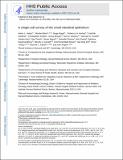A single-cell survey of the small intestinal epithelium
Author(s)
Haber, Adam L.; Biton, Moshe; Rogel, Noga; Herbst, Rebecca H.; Shekhar, Karthik; Smillie, Christopher; Burgin, Grace; Delorey, Toni M.; Howitt, Michael R.; Katz, Yarden; Tirosh, Itay; Beyaz, Semir; Dionne, Danielle; Zhang, Mei; Raychowdhury, Raktima; Garrett, Wendy S.; Rozenblatt-Rosen, Orit; Shi, Hai Ning; Yilmaz, Omer; Xavier, Ramnik J.; Regev, Aviv; ... Show more Show less
Downloadnihms910777.pdf (5.757Mb)
PUBLISHER_POLICY
Publisher Policy
Article is made available in accordance with the publisher's policy and may be subject to US copyright law. Please refer to the publisher's site for terms of use.
Terms of use
Metadata
Show full item recordAbstract
Intestinal epithelial cells absorb nutrients, respond to microbes, function as a barrier and help to coordinate immune responses. Here we report profiling of 53,193 individual epithelial cells from the small intestine and organoids of mice, which enabled the identification and characterization of previously unknown subtypes of intestinal epithelial cell and their gene signatures. We found unexpected diversity in hormone-secreting enteroendocrine cells and constructed the taxonomy of newly identified subtypes, and distinguished between two subtypes of tuft cell, one of which expresses the epithelial cytokine Tslp and the pan-immune marker CD45, which was not previously associated with non-haematopoietic cells. We also characterized the ways in which cell-intrinsic states and the proportions of different cell types respond to bacterial and helminth infections: Salmonella infection caused an increase in the abundance of Paneth cells and enterocytes, and broad activation of an antimicrobial program; Heligmosomoides polygyrus caused an increase in the abundance of goblet and tuft cells. Our survey highlights previously unidentified markers and programs, associates sensory molecules with cell types, and uncovers principles of gut homeostasis and response to pathogens.
Date issued
2017-11Department
Massachusetts Institute of Technology. Department of Biology; Koch Institute for Integrative Cancer Research at MITJournal
Nature
Publisher
Nature Publishing Group
Citation
Haber, Adam L. et al. “A Single-Cell Survey of the Small Intestinal Epithelium.” Nature 551, 7680 (November 2017): 333–339 © 2017 Macmillan Publishers Limited, part of Springer Nature
Version: Author's final manuscript
ISSN
0028-0836
1476-4687